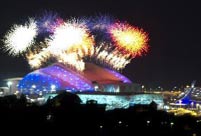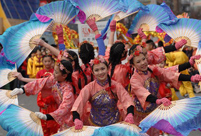 Turnip sculptures amaze tourists in Qingdao
Turnip sculptures amaze tourists in Qingdao Chinese ship formation conducts live fire training in West Pacific
Chinese ship formation conducts live fire training in West Pacific
 China comes in third at figure skating team event
China comes in third at figure skating team event
 China's teenager skater Yan shines at his Olympic debut
China's teenager skater Yan shines at his Olympic debut
 Taiwan-born actor stars on US TV series
Taiwan-born actor stars on US TV series
 Chinese Lunar New Year gift from abroad
Chinese Lunar New Year gift from abroad Chinese champions of Winter Olympic Games
Chinese champions of Winter Olympic Games  Zhang Yimou fined 7.48 mln for over-production
Zhang Yimou fined 7.48 mln for over-production
 Top 10 timeless female Chinese stars
Top 10 timeless female Chinese stars
BEIJING, Feb. 16 -- Heavy smog in Beijing lasting for days has triggered public criticism over the municipal government's inaction.
At 8 p.m. Sunday, the air quality index (AQI) at monitoring stations in the city's downtown areas read between 342 and 414 and was rated at Level 6, the highest level, indicating hazardous pollution, according to the Beijing Municipal Environmental Monitoring Center's website.
The business channel of the China Central Television (CCTV) late on Saturday questioned why the government failed to initiate an emergency response under such smoggy weather.
"Beijing municipal government, don't pretend to be blind in the fog," the channel said via its account on the Twitter-like Weibo.com. "The government should not shun its responsibility or turn a blind eye to the smog."
The channel tweeted twice on the matter in five minutes, and the post had been forwarded by netizens thousands of times as of Sunday morning.
Beijing is not the only region facing the suffocating air on Sunday. The National Meteorological Center issued a yellow alert at 6 a.m. Sunday, forecasting medium to serious haze in Beijing and nearby Tianjin Municipality and the provinces of Hebei, Shandong, Henan, Shanxi, and Shaanxi. It said smog would last until late Sunday, when a fresh wave of rain and snow would hit most of the country.
QUESTIONS OVER GOV'T INACTION
The Beijing municipal government approved and put into effect an emergency response system last October. The system requires that traffic be cut with alternate driving days for even- and odd-numbered license plates and schools suspended if a red alert, the highest level for air pollution, is issued. Industrial plants will be closed or told to reduce production and fireworks will be banned if an orange alert, the second-highest alert, is issued.
However, the government has not initiated the emergency response once since the program came into effect on Oct. 22, 2013, although the public has on several occasions complained of smog heavy enough to warrant a government response.
The government issued a blue alert for air pollution late on Saturday.
The city has a four-tier alert system, using blue, yellow, orange and red to indicate the air pollution level in order of increasing severity.
A red alert indicates the most serious air pollution, or Level 6 pollution, for three consecutive days. An orange alert indicates heavy to serious air pollution, or Level 5 to Level 6, alternately for three consecutive days.
The latest round of smog started on Friday, which marked both the traditional Chinese Lantern Festival and Valentine's Day. Holiday fireworks brought the air quality index (AQI) from more than 300 in the morning to 500 in the evening.
Residents questioned the lack of government action over the matter, believing authorities should have banned fireworks.
Wang Yuesi, a researcher with the Institute of Atmospheric Physics of the Chinese Academy of Sciences, said orange and red alerts required action by the public, such as cutting traffic, and government authorities were reluctant to issue the response as smog for three consecutive days is difficult to forecast accurately.
"Environmental authorities lacked preparation in responding to smog for both technical reasons and management reasons. All they hope is that continuous smoggy days like this never come," Wang said.
He also said the response would be useless even if traffic were cut and the plants suspended, because smog is not strictly a Beijing problem, but a common issue faced by a much larger region, including Beijing and Tianjin municipalities and the nearby provinces of Hebei, Shandong and Henan.
Wang's research last year found hazardous heavy metals in the air over Beijing came from ferrous metal smelting and coal burning in the Beijing-Tianjin-Hebei area.
On Sept. 18, the Ministry of Environmental Protection and governments of Beijing, Hebei, Inner Mongolia, Shandong, Shanxi and Tianjin signed an agreement on pollution. The Ministry of Finance announced in October a 5 billion yuan (824 million U.S. dollars) reward for air pollution reduction.
A statement released after an executive meeting of the State Council held on Wednesday has urged reduction of PM2.5 and other pollutants in smoggy cities as the key task in the fight against air pollution.
The statement noted that overall consumption of coal should be controlled, calling for more efforts to promote high quality gasoline for vehicles, energy saving in construction and the use of environmentally friendly boilers.
It revealed that 10 billion yuan (1.64 billion U.S. dollars) has been allocated this year as rewards for key cities and regions who make significant progress in air pollution control.
Ma Jun, a conservationist and founder of the non-profit Institute for Public and Environmental Affairs (IPE), said that, considering the difficulty of ordering immediate action by residents during extreme smoggy weather, the government should take easier measures.
Ma advised that the government move government-funded vehicles off of roads and, more importantly, order the suspension of plants with huge emissions, adding that the government should disclose these measures to the public in a timely manner when smoggy weather happens.
"Industrial and coal-fired power plant emissions are way more serious than those of vehicles, and it is more feasible for authorities to shut them down under extreme weather," said Ma.
INTERNATIONAL ISSUE
The smog problem in China has drawn world attention and has become an international issue requiring global efforts to solve.
According to a study in the journal Proceedings of the National Academy of Sciences in late January, 36 percent of human-caused sulfur dioxide, 27 percent of nitrogen oxides, 22 percent of carbon monoxide and 17 percent of black carbon emitted in China were associated with the production of goods for export.
About 21 percent of export-related Chinese emissions were attributed to China-to-US exports, said the study.
Chinese Premier Li Keqiang on Friday called for closer China-U.S.technological cooperation in countering climate change when U.S. Secretary of State John Kerry visited China on Friday.
Kerry also said the United States would like to strengthen coordination on climate change.
 Highlights of opening ceremony of Sochi 2014 Winter Olympic Games
Highlights of opening ceremony of Sochi 2014 Winter Olympic Games Highlights of Chinese New Year celebrations around the world
Highlights of Chinese New Year celebrations around the world  Chinese ship formation conducts live fire training in West Pacific
Chinese ship formation conducts live fire training in West Pacific Sanya bans skinny dipping in public beach
Sanya bans skinny dipping in public beach Top 20 most beautiful Chinese stars
Top 20 most beautiful Chinese stars  PLA navy conducts landing drills in South China Sea
PLA navy conducts landing drills in South China Sea  Snowscape in Chinese New Year
Snowscape in Chinese New Year Top 10 timeless female Chinese stars
Top 10 timeless female Chinese stars Top 10 Chinese films in 2013
Top 10 Chinese films in 2013 Ruins of Shang Dynasty's structure unearthed in Shaanxi
Ruins of Shang Dynasty's structure unearthed in Shaanxi  Intercity high speed train in operation for the first
Intercity high speed train in operation for the first  Severe coldness freezes large parts of China
Severe coldness freezes large parts of China  Beautiful moments of Sochi
Beautiful moments of Sochi  It's not just performing this year
It's not just performing this year Selfies of "Little colorful flag" girl unveiled
Selfies of "Little colorful flag" girl unveiled Day|Week|Month